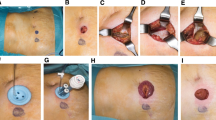Abstract
Background
Minimizing incisions has the potential to decrease hernia formation and wound complications following laparoscopic surgery. It is currently unknown if using the stoma site for specimen extraction affects outcomes. This study aims to evaluate the impact of stoma site extraction on postoperative complication rates in laparoscopic colorectal surgery.
Methods
After IRB approval, a retrospective comparative review of 738 consecutive patients (405 M) who underwent laparoscopic colorectal surgery with ileostomy between January 2008 and December 2014 was performed. Patients who had a minimally invasive surgery that required an ileostomy were included. Patients were classified into two groups: stoma site extraction (SSE) or non-stoma site extraction (NSSE) and compared by body mass index (BMI), age, comorbidities, American Society of Anesthesiologists score, length of stay, estimated blood loss, parastomal complications, and hernia rate.
Results
The parastomal hernia rate was 10.1% for the SSE group (n = 14) and 4.2% for the NSSE group (n = 25) (p = 0.007). The need for additional surgeries was 7/139 (5.0%) for the SSE group and 27/599 (4.5%) for the NSSE group (p = 0.79). There was no difference in the hernia rate after stoma closure in either group. There was no difference in single incision laparoscopic surgery versus conventional laparoscopy or robotic-assisted laparoscopy on stoma site complications in patients with SSE. SSE, transfusion, and BMI >30 were found to be independent factors associated with increased stoma site complications.
Conclusion
SSE does increase stoma site complications. SSE should be used with caution, or in conjunction with other techniques to reduce hernias in patients requiring a permanent stoma or with an elevated BMI. The increase in stoma site complications does not translate into additional surgeries or postoperative sequelae following stoma reversal and is a reasonable option in patients requiring a temporary stoma.
Similar content being viewed by others
References
Nastro P, Knowles CH, McGrath A, Heyman B, Porrett TR, Lunniss PJ (2010) Complications of intestinal stomas. Br J Surg 97:1885–1889
Laurent C, Leblanc F, Bretagnol F, Capdepont M, Rullier E (2008) Long-term wound advantages of the laparoscopic approach in rectal cancer. Br J Surg 95:903–908
Weeks JC, Nelson H, Gelber S, Sargent D, Schroeder G (2002) Clinical outcomes of surgical therapy (COST) study group. Short-term quality-of-life outcomes following laparoscopic-assisted colectomy vs open colectomy for colon cancer. JAMA 287:321–328
Randall J, Lord B, Fulham J, Soin B (2012) Parastomal hernias as predominant stoma complication after laparoscopic colorectal surgery. Surg Laparosc Endosc Percutaneous Tech 22:420–423
Singh R, Omiccioli A, Hegge S, McKinley C (2008) Does the extraction-site location in laparoscopic colorectal surgery have an impact on incisional hernia rates? Surg Endosc 22:2596–2600
Orcutt ST, Balentine CJ, Marshall CL, Robinson CN, Anaya DA, Artinyan A, Awad SS, Berger DH, Albo D (2012) Use of a Pfannenstiel incision in minimally invasive colorectal cancer surgery is associated with a lower risk of wound complications. Tech Coloproctol 16:127–132
Samia H, Lawrence J, Nobel T, Stein S, Champagne BJ, Delaney CP (2013) Extraction site location and incisional hernias after laparoscopic colorectal surgery: Should we be avoiding the midline? Am J Surg 205:264–267
Fazio Victor W, Church James M, Wu James S (2012) Atlas of intestinal stomas. Springer, New York
Jacobs M, Verdeja JC, Goldstein HS (1991) Minimally invasive colon resection (laparoscopic colectomy). Surg Laparosc Endosc 1:144–150
Lacy AM, García-Valdecasas JC, Delgado S, Castells A, Taurá P, Piqué JM, Visa J (2002) Laparoscopy-assisted colectomy versus open colectomy for treatment of non-metastatic colon cancer: a randomised trial. Lancet 359:2224–2229
Noel JK, Fahrbach K, Estok R, Cella C, Frame D, Linz H, Cima RR, Dozois EJ, Senagore AJ (2007) Minimally invasive colorectal resection outcomes: short-term comparison with open procedures. J Am Coll Surg 204:291–307
Remzi FH, Kirat H, Kaouk J, Geisler D (2008) Single-port laparoscopy in colorectal surgery. Colorectal Dis 10:823–826
Carne P, Robertson G, Friselle F (2003) Parastomal hernia. Br J Surg 90:784–793
Güenaga KF, Lustosa SA, Saad SS, Saconato H, Matos D (2008) Ileostomy or colostomy for temporary decompression of colorectal anastomosis. Systematic review and meta-analysis. Acta Cir Bras 23:294–303
Devlin HB, Kingsnorth AN (1998) Parastomal hernia, in management of abdominal hernias. Butterworths, London
Costedio MM, Aytac E, Gorgun E, Kiran RP, Remzi FH (2012) Reduced port versus conventional laparoscopic total proctocolectomy and ileal J pouch-anal anastomosis. Surg Endosc 26:3495–3499
Sulu B, Gorgun E, Aytac E, Costedio MM, Kiran RP, Remzi FH (2014) Comparison of hospital costs for single-port and conventional laparoscopic colorectal resection: a case-matched study. Tech Coloproctol 18:835–839
Duchesne J, Wang Y, Weintraub S, Boyle M, Hunt JP (2002) Stoma complications: a multivariate analysis. Am Surg 68:961–966
Donahue TF, Cha EK, Bochner BH (2016) Rationale and early experience with prophylactic placement of mesh to prevent parastomal hernia formation after ileal conduit urinary diversion and cystectomy for bladder cancer. Curr Urol Rep 17:9
Antoniou SA, Morales-Conde S, Antoniou GA, Granderath FA, Berrevoet F, Muysoms FE, Bonham Group (2016) Single-incision laparoscopic surgery through the umbilicus is associated with a higher incidence of trocar-site hernia than conventional laparoscopy: a meta-analysis of randomized controlled trials. Hernia 20(1):1–10
Author information
Authors and Affiliations
Corresponding author
Ethics declarations
Disclosures
Wanglin Li, Cigdem Benlice, Luca Stocchi, Hermann Kessler, Emre Gorgun, Meagan Costedio have no conflicts of interest including relevant financial interests, activities, relationships, and affiliations.
Rights and permissions
About this article
Cite this article
Li, W., Benlice, C., Stocchi, L. et al. Does stoma site specimen extraction increase postoperative ileostomy complication rates?. Surg Endosc 31, 3552–3558 (2017). https://doi.org/10.1007/s00464-016-5384-x
Received:
Accepted:
Published:
Issue Date:
DOI: https://doi.org/10.1007/s00464-016-5384-x




